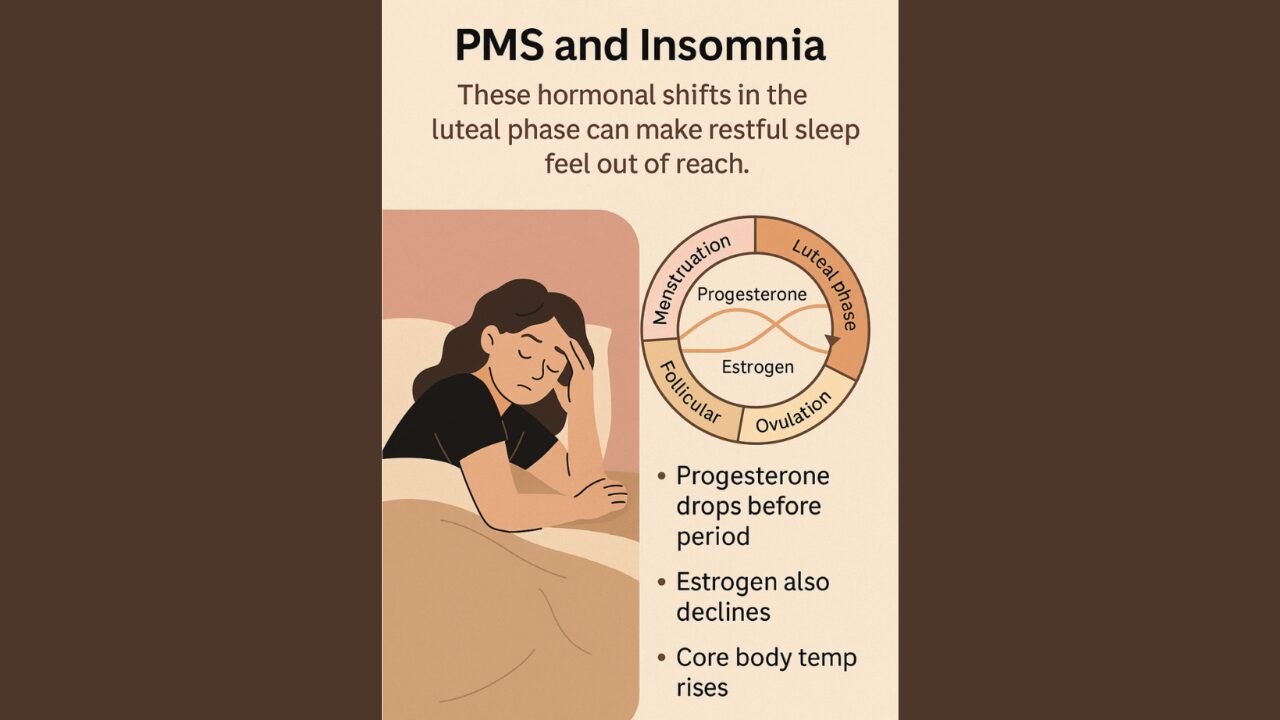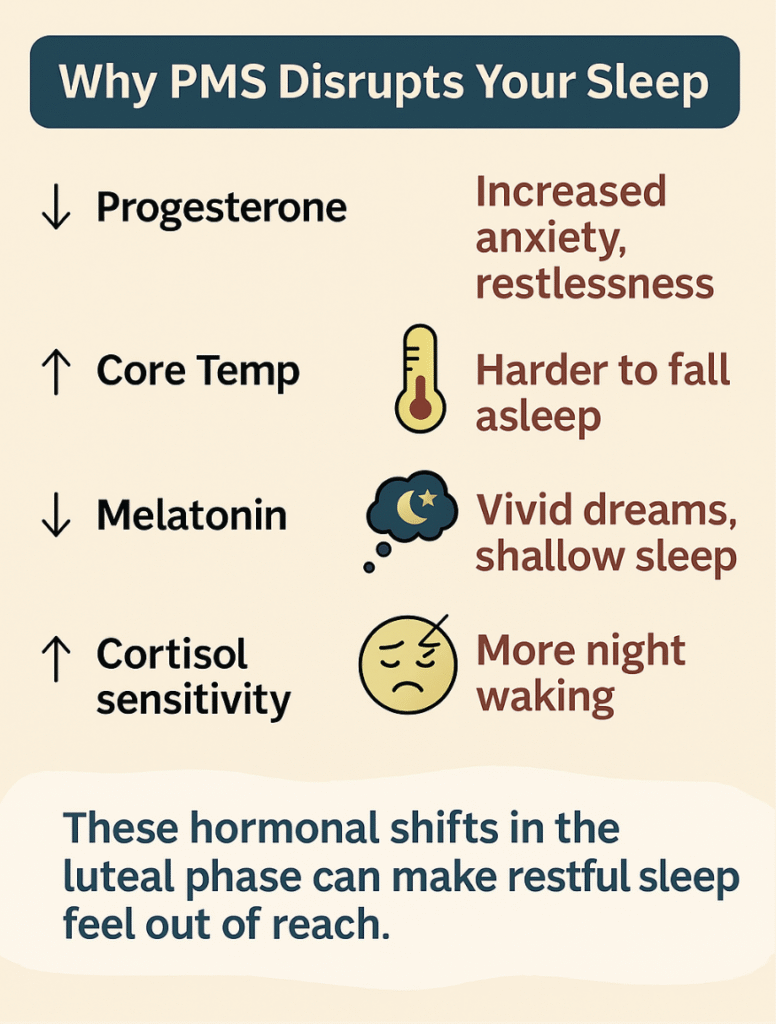PMS and Insomnia: Why Your Period Disrupts Your Sleep

It’s 2 a.m., and you’re still awake. You’ve been tossing and turning for hours, your body tired but your mind racing. Your period’s due in a day or two — and like clockwork, sleep becomes harder to find.
You’re not imagining it. Studies show that nearly 7 in 10 women experience sleep disturbances during the days leading up to their period. From night waking and restless legs to vivid dreams and anxiety spikes, PMS-related insomnia is more common than most people realize — yet it often goes undiscussed.
The reason? Hormones. As your body prepares for menstruation, shifting hormone levels can interfere with temperature regulation, mood stability, and the brain’s sleep-wake rhythm.
In this article, we’ll uncover what’s happening in your body before your period — and how understanding your hormonal rhythms can help you finally sleep better.
Why You Can’t Sleep Before Your Period

If you’ve ever wondered, “Why can’t I sleep before my period?” — you’re asking the right question. The answer lies in your hormones.
During the second half of your menstrual cycle — the luteal phase — progesterone and estrogen levels begin to fluctuate. Progesterone, which has natural calming and sleep-promoting effects, starts to drop sharply just before your period. This hormonal shift can leave you feeling more restless, anxious, and emotionally sensitive than usual.
At the same time, your core body temperature tends to rise slightly, a subtle change that can make it harder to fall and stay asleep. Most people sleep best when their body temperature drops at night, so even a slight temperature bump can reduce their natural rhythm.
Add to that a heightened sensitivity to stress and changes in melatonin production, and it’s no surprise that PMS and insomnia often go hand in hand. Research shows that women in their premenstrual phase are more likely to experience insomnia before their period, along with increased fatigue during the day.
While these changes are regular, they don’t have to feel like a mystery. In the following sections, we’ll explore what PMS insomnia looks like and how you can track and manage it.
How Hormones and Temperature Disrupt Sleep
Your menstrual cycle isn’t just about your period — it’s a full-body hormonal journey that affects everything from mood to metabolism to sleep. One of the most prominent behind-the-scenes players? Your temperature.
In the days after ovulation, your body releases more progesterone, a hormone that supports potential pregnancy and raises your core body temperature by about 0.3–0.5°C. This subtle but consistent rise in temperature continues through the luteal phase until your period starts, and it plays a key role in PMS-related sleep issues.
Why does that matter? Because your body sleeps best when your internal temperature drops. This is especially true for entering and maintaining deep sleep. So when your body runs slightly hotter than usual, it can throw off your sleep rhythm, causing more tossing, frequent waking, or difficulty falling asleep.
That’s why many women experience lighter sleep, vivid dreams, or feel like they never hit full rest mode during PMS. Yet few people connect those restless nights with the hormone-induced temperature shifts.
Tracking these changes, especially temperature and sleep patterns, can give you the missing puzzle. Today, tools like a temperature ring or smart ring temperature tracking can help you spot these shifts in real-time. By identifying how your temp menstrual cycle patterns align with your sleep quality, you can begin to understand your rhythms and make smarter choices about supporting your body through them.
What Real PMS Sleep Disruption Looks Like
PMS insomnia doesn’t always feel like classic insomnia. It can sneak in with subtle, frustrating symptoms that repeat every month, and many women don’t even realize it’s part of their cycle.
Some lie in bed for hours, physically exhausted but mentally overstimulated. Others fall asleep quickly but wake up at 3 or 4 a.m., unable to drift back into rest. Nightmares, vivid dreams, or an anxious, racing mind are common signs.
You might also notice that your sleep feels “lighter” than usual, as if you never truly enter deep rest. You may wake up still tired, no matter how many hours you spent in bed.
This pattern can affect your energy, focus, and mood during the day, but without a clear explanation, it’s easy to brush it off as just “stress” or “random bad sleep.”
The truth is, real PMS sleep disruption is often the result of predictable hormonal and physiological changes. And when you begin to recognize the signs, especially if they repeat at the same time each month, you’re already one step closer to taking control of them.
How a Sleep Ring Reveals Hidden Sleep Patterns
If you’ve ever tried to journal your sleep or track symptoms during PMS, you know how hard it is to notice patterns, especially when everything feels like a blur. This is where a sleep ring can genuinely help.
Unlike traditional sleep apps or wearables, a bright ring is lightweight, discreet, and designed for continuous, passive monitoring. It can track subtle changes in your skin temperature, sleep stages, and even overnight restlessness, giving you a clearer picture of how your body behaves throughout your cycle.
For example, you may notice that your deep sleep drops right before your period, or that your body temperature stays slightly elevated during your luteal phase. Over time, these patterns become easier to spot and to plan around.
With a lightweight sleep ring like RingConn Gen 2 Air, you don’t have to guess what’s happening. You’ll have real, personalized insights that help you understand your hormonal rhythms — without adding stress or effort to your routine.
This kind of data doesn’t just validate your experience — it empowers you to respond to it.
Note: RingConn also offers a standard model, the Gen 2, which includes additional features like sleep apnea detection and a portable charging case. If you’re looking for a more advanced option, it’s worth comparing the two to see which best suits your needs.
Step-by-Step: How to Track PMS Sleep with a Ring

You don’t need to be a data expert to make this work. Here’s how to turn your bright ring into a simple cycle-awareness companion:
- Wear the ring consistently
Smart rings like RingConn Gen 2 Air are designed for all-day, all-night wear. The more consistently you wear them, the better the device can learn your patterns, including when your sleep quality drops during PMS. - Pay attention to temperature trends
Most smart rings track your skin temperature while you sleep. You’ll likely see a subtle increase in temperature during your luteal phase — this is a regular part of your menstrual cycle. Noticing how this shift aligns with changes in your sleep can help explain your PMS insomnia. - Monitor sleep stages across your cycle
Watch for changes in deep sleep, REM, and overall restfulness as your period approaches. If your deep sleep decreases and you wake more often, these could be early signs of premenstrual disruption. - Track your symptoms alongside the data
Whether you experience bloating, mood swings, or fatigue, logging how you feel alongside your sleep and temperature data can provide a complete picture and help you respond more effectively. - Use insights to plan and adapt
Once you know your typical PMS window, you can adjust your sleep habits ahead of time: wind down earlier, avoid caffeine, or build in time to decompress. The ring doesn’t fix the symptoms, but it helps you work with your cycle instead of fighting it.
With time, your period ring tracker becomes more than just a tool—it becomes a personal guide to better rest throughout the month.
READ MORE
Final Tips: Sleep Better with PMS Awareness
You no longer have to fear the nights before your period. Understanding your cycle — and how it affects your sleep — is the first step toward taking back control.
Observing your body’s signals gives you clarity rather than guessing why you’re exhausted, moody, or awake at 3 a.m. A bright ring that monitors temperature and sleep can uncover patterns you may have missed, helping you link your hormones to your rest.
Even small changes — like adjusting your bedtime during your PMS window or cutting back on stimulants — can have a significant impact when timed right. And when those changes are based on real, personalized data, they’re far more sustainable.
Remember, you’re not “bad at sleeping.” Your body is following a rhythm, and with the right tools and awareness, you can work with it, not against it.
Rest isn’t a luxury during PMS. It’s a form of self-respect.
